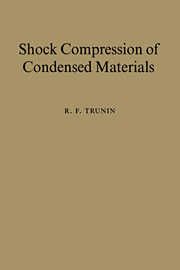9 - Conclusion
Published online by Cambridge University Press: 03 December 2009
Summary
To end this review, let us summarize the results of decades of research on the shock compression of condensed matter carried out in Russia.
Metals and numerous metallic compounds have been the subjects of the most intense research. The only group of these materials not studied under shock pressure is phosphides, which are relatively rare.
The number of experiments with minerals and oxides has been fairly large. Since the number of classes of these materials is enormous, the experimental data have been generalized to predict Hugoniots of similar materials in a wide range of shock parameters.
Research on shock compression of liquid condensed materials was started much later, but has been intense over recent years. However, the most interesting discoveries in this field related, in particular, to fast chemical reactions are expected in the late 1990s.
In conclusion let us consider some urgent tasks in the field of the shock compression of materials with a view to applying the results to the derivation of equations of state.
Primarily, this is further research into the compression of various materials at maximum pressures available in laboratory experiments. The aim is to obtain Hugoniots of solid (i.e., with a density ρ0 = ρ0,cr), porous (ρ0 < ρ0,cr), and superporous (ρ0 ≪ ρ0,cr) materials.
Another important task is to develop a technique for measuring the compressibility of heated and precompressed vapors of materials, first of all, metals, with an initial density ρ0 < 0.1 g/cm3. The behavior of melted materials with initial temperatures T > 1500 – 1700° C should be also studied.
- Type
- Chapter
- Information
- Shock Compression of Condensed Materials , pp. 154 - 156Publisher: Cambridge University PressPrint publication year: 1998

